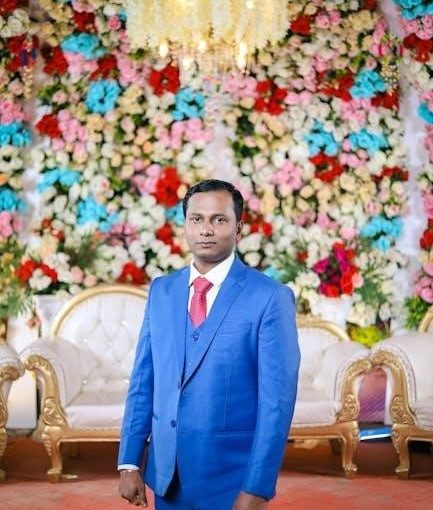Classic Suit Colors
Timeless options include navy blue, charcoal gray, black, and light gray. Navy suits are versatile for professional and social events, while charcoal gray offers a sleek, neutral look. Black suits are reserved for formal occasions, and light gray provides a modern, elegant appearance for business settings.
1.1 Navy Blue Suits
Navy blue suits are a timeless and versatile choice, ideal for both professional and social settings. They complement a wide range of shirt and tie combinations, making them suitable for various occasions. A navy suit exudes confidence and sophistication, pairing well with black or brown leather shoes for a polished appearance. Its adaptability makes it a wardrobe staple, perfect for formal events, business meetings, or even semi-formal gatherings. The classic appeal of navy blue ensures it remains a top choice for men seeking a reliable and stylish option. Its versatility allows for easy coordination with accessories, creating a balanced and elegant look.

1.2 Charcoal Gray Suits
Charcoal gray suits are a sleek and neutral choice, offering a modern aesthetic that works well in professional environments. They are versatile enough to pair with a variety of shirt and tie combinations, making them ideal for business meetings and formal events. Charcoal gray is slightly darker than light gray, providing a sharp, polished appearance that exudes professionalism. It complements most skin tones and is a practical option for everyday wear. When paired with subtle patterns or bold accessories, charcoal gray suits create a balanced, sophisticated look. Their timeless appeal makes them a wardrobe essential for men seeking a versatile and elegant option.
1.3 Black Suits
Black suits are reserved for the most formal occasions, such as weddings, funerals, and black-tie events. They exude elegance and sophistication, making them a staple in every man’s wardrobe. A well-tailored black suit creates a sleek, polished appearance and is often paired with a white shirt and black tie for a timeless look. While less common for everyday business use, black suits are ideal for situations requiring maximum formality. Their versatility allows them to complement a range of accessories, ensuring a sharp and professional image. For events demanding the highest level of dress, a black suit remains the ultimate choice for men seeking to make a refined statement.
1.4 Light Gray Suits
Light gray suits are a modern and versatile choice, offering a balance between formality and approachability. Ideal for business settings and semi-formal events, they create a sharp, contemporary look. Pairing well with white or light-colored shirts, light gray suits are perfect for spring and summer. They can be styled with patterned ties for a dynamic appearance or kept minimal for a sleek look. While less traditional than navy or charcoal, light gray suits are increasingly popular for their fresh, stylish appeal. They are a great addition to a man’s wardrobe, providing a refined yet modern alternative to darker hues.
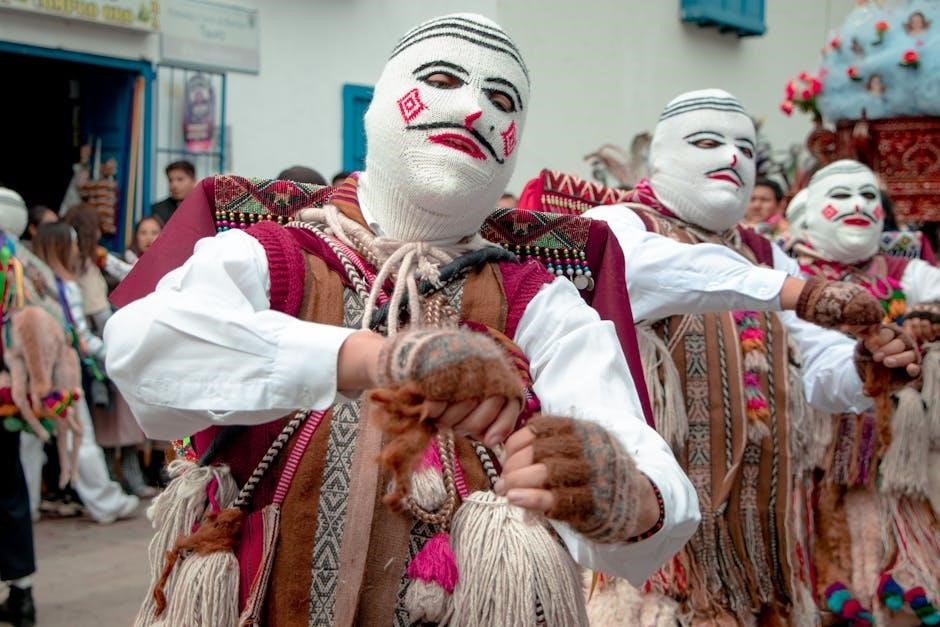
Less Common Suit Colors
Beige, tan, brown, and white suits offer unique alternatives to classic colors. Beige and tan suits are perfect for casual events, while brown suits add an earthy touch. White suits make bold statements for summer or festive occasions, though less common in formal settings. These colors provide versatility for those seeking to stand out while maintaining style.
2.1 Beige and Tan Suits
Beige and tan suits are ideal for casual and warm-weather events. These light neutrals create a relaxed yet polished look. Pair beige suits with earthy tones like brown shoes and tan accessories for a cohesive style. Tan suits complement pastel-colored shirts and patterned ties, adding versatility. Perfect for summer weddings or outdoor gatherings, these suits offer a refreshing alternative to traditional navy or gray. Ensure proper fit for a modern aesthetic, as these colors can easily transition from daytime to evening events with the right accessories and styling choices.
2.2 Brown Suits
Brown suits are a sophisticated choice, offering warmth and character. They are ideal for autumn and winter, pairing well with earthy tones like olive or terracotta. A lighter brown suit can add a stylish touch to casual events, while darker shades like chocolate brown are perfect for formal settings. Brown suits complement patterned shirts and ties with subtle textures or earthy tones. Pair with leather accessories like brown loafers or Chelsea boots for a polished look. This versatile color bridges the gap between casual and formal wear, making it a great addition to a well-rounded wardrobe for unique and elegant styling opportunities.
2.3 White Suits
White suits exude elegance and sophistication, making them a bold choice for special occasions. Ideal for summer weddings or tropical events, they offer a fresh, vibrant look. Pairing a white suit with a light-colored shirt and neutral accessories ensures a classy appearance. Slim-fit designs enhance the modern appeal, while subtle patterns or textures can add depth. White suits are best reserved for formal or festive settings, as they stand out and command attention. Proper tailoring is essential to maintain a polished look, ensuring the suit complements the wearer’s physique. This distinctive color choice is perfect for those seeking to make a stylish statement at unique events.
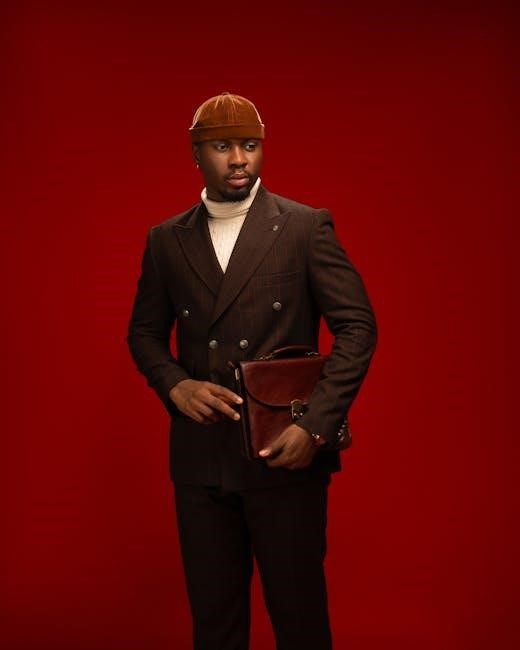
Suit Colors for Specific Occasions
Navy blue suits excel in professional and social events, while black suits are reserved for formal occasions. Light gray offers a modern look for business settings, ensuring versatility across events.
3.1 Formal Events
For formal events, navy blue and black suits are ideal choices. Navy blue is timeless and sophisticated, suitable for weddings and galas, while black suits convey elegance and are perfect for black-tie events. Charcoal gray can also be appropriate for high-level formal occasions, offering a sleek appearance. These colors ensure a polished look, aligning with the dress code expectations of formal gatherings. Pairing these suits with neutral or muted accessories enhances their classic appeal, creating a cohesive and stylish outfit for any formal setting.
3.2 Business Settings
In professional environments, navy blue, charcoal gray, and light gray suits are the most popular choices. Navy blue is versatile and conveys authority, making it ideal for corporate meetings and presentations. Charcoal gray offers a sleek, modern look that balances professionalism with subtlety, while light gray suits are suitable for less formal business settings. These colors are neutral enough to pair with a variety of shirts and ties, ensuring a polished appearance. Opting for classic styles in these tones creates a professional image, making them essential for business wardrobes. They are versatile, timeless, and appropriate for most workplace cultures and hierarchies.
3.3 Social Gatherings
Social gatherings offer more flexibility in suit choices, allowing for a balance between style and formality. Navy blue and charcoal gray suits remain popular for their versatility, while lighter gray or beige/tan suits can add a modern touch. For less formal events, brown or even white suits can make a statement, though they are less common. Accessories like shoes and ties can elevate the look, adding pops of color. Lighter tones project a stylish, approachable image, making them ideal for events like weddings or parties. These colors ensure a polished yet festive appearance, catering to the occasion’s vibe while maintaining sophistication.
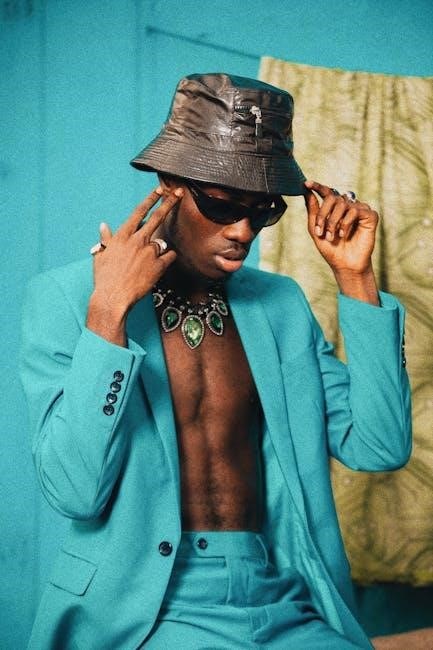
Suit Fabric Patterns
Suit fabric patterns add texture and visual interest. Solid-colored suits offer simplicity, while pinstripes create a classic, professional look. Textured fabrics like tweed or plaid add depth and character.
4.1 Solid-Colored Suits
Solid-colored suits are a classic choice, offering simplicity and versatility. They work well in both professional and formal settings, as they provide a clean, polished appearance. Navy blue, charcoal gray, and black are popular options, while lighter shades like light gray or beige are ideal for warmer weather or less formal events. Solid suits are easy to pair with patterned shirts and ties, allowing for personal expression without overwhelming the outfit. They are also timeless, ensuring the suit remains fashionable for years to come. This makes solid-colored suits a practical and stylish investment for any man’s wardrobe.
4.2 Pinstripe Suits
Pinstripe suits add a touch of sophistication and classic elegance to any outfit. These suits feature thin, parallel stripes, typically in shades that complement the base color, such as navy with white stripes or charcoal gray with subtle patterns. Pinstripes create a slimming effect and are often associated with professional environments. They are ideal for business meetings, formal events, and high-profile settings. While they are versatile, pinstripe suits are best paired with solid-colored shirts and ties to avoid visual overload. This ensures the stripes remain the focal point, enhancing the overall polished appearance of the wearer. Pinstripes are a timeless choice for those seeking a refined look.
4.3 Textured Fabrics
Textured fabrics add depth and visual interest to suits, offering a unique aesthetic beyond solid colors or pinstripes. Materials like herringbone, tweed, and velvet create intricate patterns and dimensional effects. These fabrics are ideal for making a statement while maintaining sophistication. For example, a herringbone suit provides a subtle, organic texture, while velvet offers a luxurious, smooth feel. Tweed suits, with their earthy, woven appearance, are perfect for rustic or casual-formal settings. Textured fabrics are versatile, suitable for both formal events and business meetings, and can elevate a man’s style by adding character to his wardrobe. They are a great choice for those seeking a distinctive yet elegant look.

Accessories and Color Coordination
Accessories like shoes, shirts, and ties should complement the suit color. Black or brown leather shoes are ideal, while shirts and ties should match or contrast subtly. Belts and ties should align for a polished look, ensuring a cohesive and stylish appearance.
5.1 Shoes
Shoes play a crucial role in completing the suit look. Black or brown leather shoes are recommended, with black Oxfords being a classic choice for formal events. Ensure the shoe color matches the suit and belt for a cohesive appearance. Brown shoes complement earth-toned suits like tan or olive, while black shoes pair well with navy, gray, or black suits. Avoid casual styles like sneakers in formal settings. Polished loafers or derbies are versatile options for business attire. Proper footwear enhances the overall sophistication of the outfit, making it essential to select styles that align with the occasion and suit color.
5.2 Shirts and Ties
Shirts and ties are essential for completing a polished suit look. A white shirt is a classic choice, offering versatility and a clean appearance. Light-blue shirts provide a subtle contrast, while patterned shirts add personality. Ties should complement the suit color; for navy or charcoal suits, opt for darker or patterned ties. Lighter-colored suits pair well with pastel or textured ties. Ensure the tie’s color or pattern doesn’t clash with the suit or shirt. For a cohesive look, balance bold elements with neutral ones. If wearing a patterned tie, choose a simple shirt, and vice versa. Coordination ensures a stylish, put-together outfit.
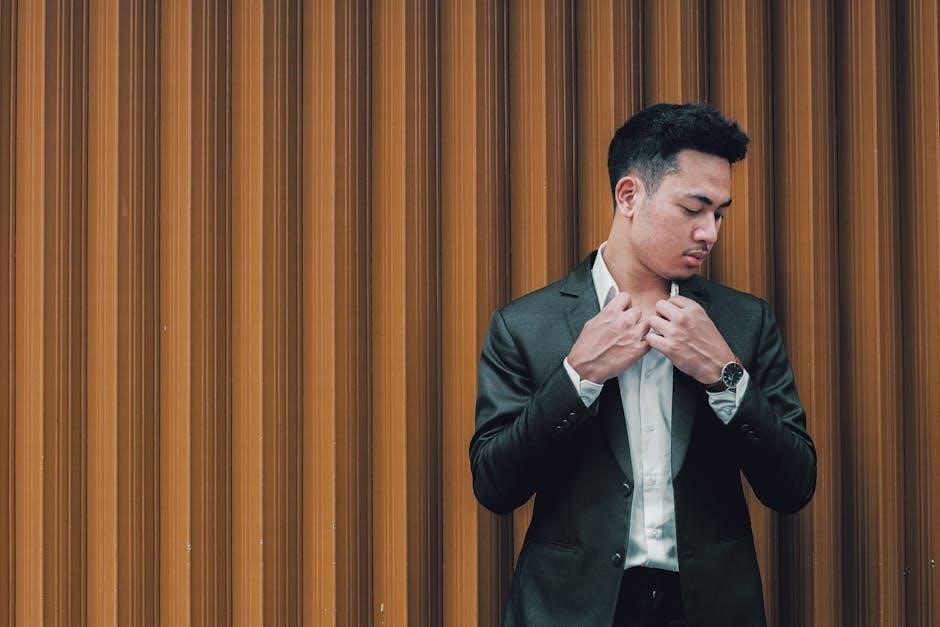
Tips for Choosing the Right Suit Color
Consider navy blue for versatility across occasions. It suits formal events and business settings, ensuring a polished and timeless appearance while complementing various shirt and tie combinations.
6.1 Skin Tone Considerations
Choosing a suit color that complements your skin tone is essential for a polished look. For lighter skin tones, navy blue and light gray suits create a sharp, balanced appearance. Darker skin tones are enhanced by charcoal gray and black suits, which provide a sleek contrast. Neutral shades like beige or tan can also work well, depending on personal style. Ensuring the suit color harmonizes with your complexion ensures a cohesive and flattering outfit. Additionally, coordinating accessories like shoes and ties can further enhance the overall aesthetic. This consideration helps in making a strong, confident statement in any setting.
6.2 Personal Style
Personal style significantly influences suit color choices. A well-tailored suit in a color that reflects your personality enhances confidence; Bold patterns like pinstripes or textured fabrics can add flair for those who want to stand out. Classic solid colors, such as navy or charcoal, offer a timeless look for a more reserved aesthetic. Consider skin tone: cooler tones may suit grays and blues, while warmer tones might favor earthier shades. Accessories like ties and shirts can add personality, allowing subtle or vibrant accents. Balancing bold elements with neutral ones ensures a polished look. Ultimately, your suit color should align with your personal style to create an authentic, confident appearance.

Mixing and Matching Suit Colors
Mixing and matching suit colors allows for creative versatility while maintaining style. Pairing a navy jacket with gray trousers creates a sharp, modern look. Charcoal gray suits can be paired with light gray or navy for a cohesive yet varied appearance. Earth tones like brown or tan offer a unique contrast when combined with neutral shades. Ensure the colors complement each other in terms of hue and texture. Accessories like ties and shirts can bridge the gap between contrasting suit colors. Experimentation is key, but balance is essential to avoid clashing. This approach adds personal flair to your wardrobe while keeping it sophisticated and stylish.
